In
other words, when a particular plot of land is occupied
by small and marginal peasants working on household
farms it is likely to show higher use of labour than
when the same plot is taken over by a large farmer
using hired labour. Not all of this may be disguised
unemployment, since the fact that small/marginal cultivators
also use other non-land inputs more intensively suggests
that they would use this additional labour to increase
per hectare productivity.
Therefore, the phenomenon that is observed at the
all-India level, of increasing landlessness (even
in terms of occupancy holdings) of the rural population,
may also lead to less employment generation in agriculture.
In addition, households who operate less than 0.4
hectare of land can be described as just below marginal,
in that their holdings are unlikely to provide subsistence
for all the household members. This means that the
possibilities of employing all household members on
that particular plot of land are fewer, and they will
be forced to seek outside employment. This proportion
is also indicated in Chart 1, where it is evident
that the total proportion of such households (landless
plus marginal) by 1999–2000 was nearly two-thirds
of the total number of rural households.
The question then remains, why has the proportion
of landless population increased so substantially
over these two periods? This may actually be a comment
on the reduced viability of small farms, given the
various changes that have occurred in the countryside
during this time.
One of the more crucial changes has been the virtual
collapse of rural credit in the organized sector,
especially for small cultivators. The reduced availability
of credit, which has been documented, has very severe
implications for the functioning of small farms in
particular. A number of input costs have also increased,
as fertilizer subsidies were sought to be reduced
and water rates and other user charges have gone up.
In addition, there is some evidence that although
real wage growth slowed down substantially during
the nineties, real wage rates continued to increase
in most parts of the country. Since the seasonality
of agricultural operations means that most cultivators,
whatever the size of holding, need to hire in some
labour during the peak seasons, this has the dual
effect of increasing costs and raising the opportunity
cost of own cultivation.
The process of trade liberalization has meant that
domestic agricultural prices have less relation to
domestic demand and supply conditions and are more
correlated with international price movements than
before. This means that even when the harvest is poor
or when there is crop failure, the cultivators do
not get any recompense in terms of higher prices.
There is much greater use of a range of monetized
inputs, including new varieties of seed marketed by
major multinational companies. Small cultivators who
take on debts (often from informal credit sources
at very high rates of interest) in order to pay for
these cash inputs find themselves in difficulty if
for some reason there is crop failure or output prices
remain low.
All these could be why the proportion of rural households
not operating any land increased so much over this
period. This in turn would mean that are less people
reporting themselves as self-employed in agriculture
(which is what is observed), and a general reduction
in employment generation because less people would
be hired than had lost employment from own cultivation.
Is this aggregate pattern reflected across individual
states? Charts 3 to 17 provide some indication of
landholding changes (in terms of the proportion of
landless and marginal households to the total) along
with rates of growth of agricultural employment generation
over these two periods, in the major states.

Chart
3 >> Click
to Enlarge

Chart
4 >> Click
to Enlarge
In these charts, the columns
describe the proportion of landless and marginal (that
is, those operating holdings less than 0.4 hectare)
households in the years 1987–88, 1993–94 and 1999–2000.
The line describes the growth of agricultural employment
in the first and second periods.
It is clear that the pattern of greater landlessness
is common to all the states. A significant majority
of the states also show substantially reduced agricultural
employment growth. The extent of the deceleration
varies from state to state but it is usually quite
sharp.
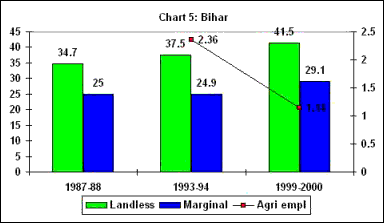
Chart
5 >> Click
to Enlarge
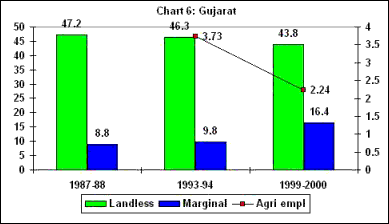
Chart
6 >> Click
to Enlarge
Only three states show the opposite tendency in terms
of agricultural employment-Haryana, Punjab and West
Bengal. In the case of Haryana (Chart 7), this is
not of much significance because in both periods agricultural
employment growth was negative.
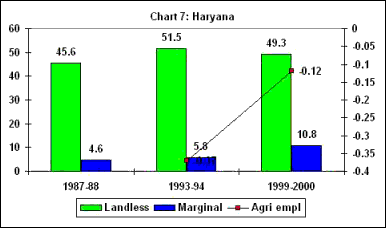
Chart
7 >> Click
to Enlarge

Chart
8 >> Click
to Enlarge
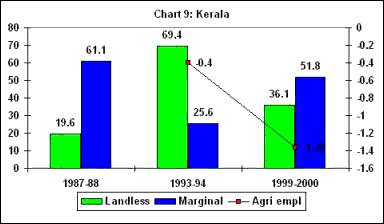
Chart
9 >> Click
to Enlarge

Chart
10 >> Click
to Enlarge

Chart
11 >> Click
to Enlarge
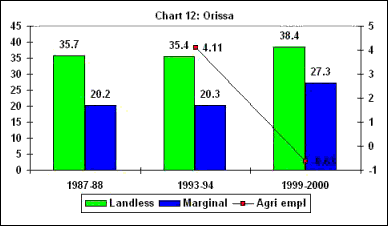
Chart
12 >> Click
to Enlarge
In Punjab (Chart 13), agricultural employment moves
from a negative rate of –1.14 per cent to a positive
rate of 1.47 per cent, which is a reasonably large
shift and the opposite of what has occurred in most
other parts of the country. It should be noted, however,
that in this state the proportion of landless households
remained broadly constant in the latter period, suggesting
that the role of changing land relations was minimal.
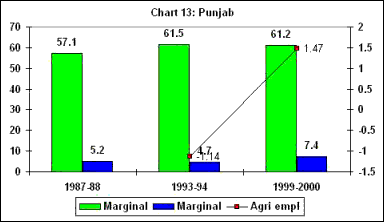
Chart
13 >> Click
to Enlarge
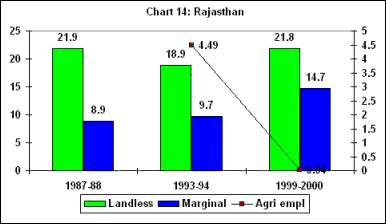
Chart
14 >> Click
to Enlarge
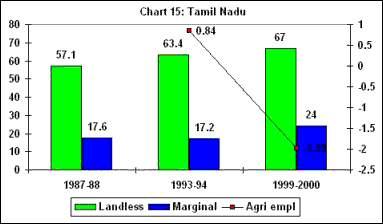
Chart
15 >> Click
to Enlarge
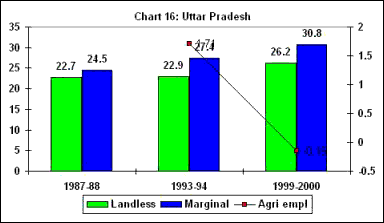
Chart
16 >> Click
to Enlarge
West
Bengal (Chart 17) presents the most interesting case.
Here, there has been a significant increase in the
landless population (up by 10 percentage points of
total households); yet, agricultural employment appears
to have accelerated over the latter period, going
up from a negative rate of –0.36 per cent to a positive
rate of 0.54 per cent. This process clearly deserves
further examination. It is possible that cropping-pattern
changes have been such as to induce greater labour-use,
and there may have been other changes in the countryside
which have translated into greater availability of
work in agriculture.
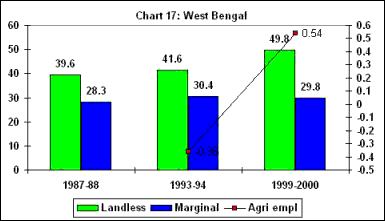
Chart
17 >> Click
to Enlarge

